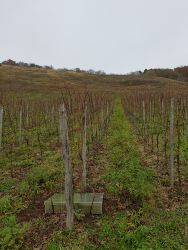The Continental regional groupof the Diverfarming project informed students of the Mosel-viniculture school Bernkastel-Kues about cover crops and diversification in steep slope vineyards.
The Continental regional group investigates the effects of intercropping grapevine and aromatic plants. Following WP10 “Coordination and Dissemination” the Continental regional group organised a training school for viticulture students to teach advantages of cover crops and diversification in steep slope vineyards.
Due to the Covid-19 restrictions, the seminar was heldonline. 30 participants from the viniculture school Mosel in Bernkastel-Kues attended the meeting (27future winemakers, 3teachersplus the organisers). The meeting took place on December 18, and started at 09:45 am and lasted until 12:00 pm.
Cord-Henrich Treseler (Weingut Dr. Frey) conducted the training school. Thomas Iserloh, Manuel Seeger and Felix Dittrich from Trier University werepresent and were at disposal for questions and discussions.
Cord-Henrich Treseler reported about the importance of vegetation management in vineyards in general and about diversification in particular. He talked about cover crops in driving lanes and intercropping vines with perennial herbs.
 A fundamental issue of steep slope viticulture is related to vegetation management below the vines. In order to overcome problems of soil erosion and soil organic matter depletion, an increasing number of winemakers is establishing cover crops in driving lanes,such as grasses and legumes. On the contrary, the area underneath the vines is typically kept free of vegetation to avoid fungal diseases and competition on water, increasing the risk of soil erosion and degradation of soil quality. As cover crops do not benefit to the value chain and may compete with vines on water or have other adverse effects on vine performance, an alternative strategy for vegetation management underneath vines in steep slope viticulture is required.
A fundamental issue of steep slope viticulture is related to vegetation management below the vines. In order to overcome problems of soil erosion and soil organic matter depletion, an increasing number of winemakers is establishing cover crops in driving lanes,such as grasses and legumes. On the contrary, the area underneath the vines is typically kept free of vegetation to avoid fungal diseases and competition on water, increasing the risk of soil erosion and degradation of soil quality. As cover crops do not benefit to the value chain and may compete with vines on water or have other adverse effects on vine performance, an alternative strategy for vegetation management underneath vines in steep slope viticulture is required.
Therefore, intercropping vines with perennial aromatic herbs like Thyme and Oregano growing underneath is a promising cropping practice to address the abovementioned issues. Both herbs are economically valuable and originate from dry and warm environments, which are typical for most viticultural areas.
Furthermore, their relatively low need for water and flat-growing habitus is assumed to be suitable to cover the soil underneath the vines in order to protect against erosion and suppress weeds without having adverse effects on vine growth and –health without generating water competition with the grapewine. They may be marketed directly or indirectly as a concentrate for cosmetics, perfumes, nutritional supplements and food.
Finally, he reported the first results of “WP3Crop production and quality” and explained the work effort to establish, maintain and harvest the herbs under vine from the authentic perspective of a winemaker. Moreover, he informed about wine quality, and gave insight about economic benefits and drawbacks, extending his classes onto the concept of land equivalent ratio.
Diverfarming is a project financed by the Horizon 2020 Programme of the European Commission, within the challenge of “Food Security, Sustainable Agriculture and Forestry, Marine, Maritime and Inland Water Research and the Bioeconomy”, under agreement 728003. It counts on the participation of the Universities of Cartagena and Córdoba (Spain), Tuscia (Italy), Exeter and Portsmouth (United Kingdom), Wageningen (Netherlands), Trier (Germany), Pecs (Hungary) and ETH Zurich (Switzerland), the research centres Consiglio per la ricerca in agricoltura e l'analisi dell'economia agraria (Italy), the Consejo Superior de Investigaciones Científicas (Spain) and the Natural Resources Institute LUKE (Finland), the agrarian organisation ASAJA, and the companies Casalasco and Barilla (Italy), Arento, LogísticaDFM and Industrias David (Spain), Nieuw Bromo Van Tilburg and Ekoboerdeij de Lingehof (Netherlands), Weingut Dr. Frey (Germany), Nedel-Market KFT and Gere (Hungary) and Paavolan Kotijuustola and Polven Juustola (Finland).










